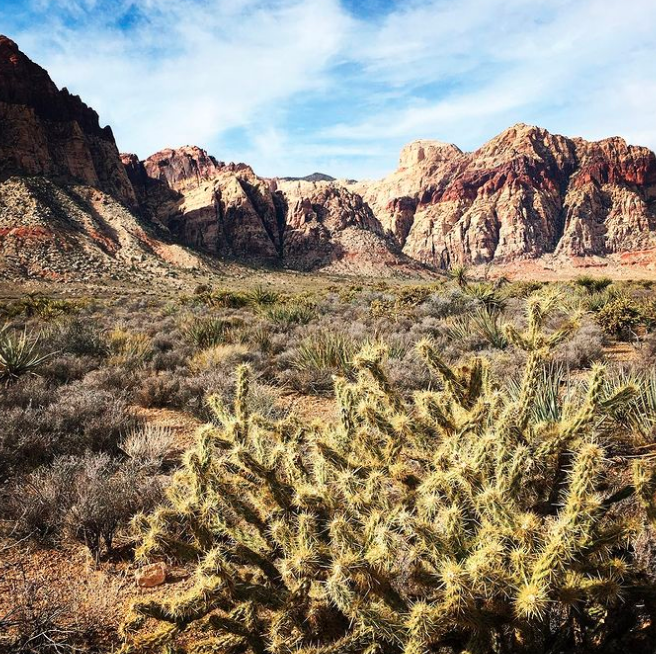- calendar_month January 13, 2025
Red Rock Canyon, located near Las Vegas, Nevada, is one of the most iconic natural landmarks in the United States, known for its towering sandstone cliffs, unique geological formations, and rich biodiversity. However, its tranquil beauty is now at the center of a heated debate, as plans move forward for a large-scale housing development on Blue Diamond Hill, a ridge overlooking this beloved conservation area.
This project has not only stirred emotions among environmentalists and residents but has also raised critical questions about balancing the needs for urban development with the preservation of fragile ecosystems.
The Proposed Development: What’s Happening?
The Clark County Zoning Commission recently approved a controversial project allowing the construction of a 3,500-home community atop Blue Diamond Hill. Developer Jim Rhodes, who has been advocating for this project for decades, initially proposed more than 5,000 homes. After prolonged legal battles and public outcry, a settlement was reached, reducing the scope of the project to its current size
- Location: The development site sits on a former gypsum mine and serves as a natural barrier between Las Vegas' urban sprawl and the protected lands of Red Rock Canyon.
- Accessibility: Plans indicate that traffic for the community will primarily flow through State Routes 159 and 160, which are already busy corridors. This has raised concerns about road congestion and safety in the area.
Why Is This Project So Controversial?
1. Environmental Concerns
The proximity of the development to Red Rock Canyon raises alarms about its impact on the surrounding ecosystem. Red Rock is home to a variety of wildlife, including desert tortoises, bighorn sheep, and peregrine falcons, all of which rely on the undisturbed habitat for survival. Critics fear the project could lead to:
- Habitat loss and fragmentation.
- Increased light and noise pollution, disrupting nocturnal species and degrading the park’s pristine dark skies.
- Strain on limited water resources in the desert environment.
2. Traffic and Infrastructure
State Route 159, a picturesque road often used by cyclists and tourists heading to Red Rock, is expected to bear the brunt of increased traffic. Opponents argue that this would compromise safety and detract from the scenic experience of visitors to the canyon.
3. Cultural and Recreational Impact
Red Rock Canyon is more than just a geological treasure; it’s a hub for outdoor recreation, drawing over a million visitors annually for hiking, rock climbing, and photography. Many fear that the development will erode the area’s natural charm, potentially deterring tourists and diminishing its cultural significance.
Supporters’ Perspective: Why Move Forward?
Proponents of the development argue that it is a necessary step to meet the growing housing demand in the Las Vegas area. With the population of Clark County continuing to expand, affordable housing options are in high demand. They also point out that the project will repurpose land previously used for mining, turning it into residential space rather than leaving it barren.
The county’s decision to approve the reduced-scale development was described as a “compromise” to address these competing needs while limiting the project’s footprint.
The Fight to Protect Red Rock Canyon
Environmental advocacy groups like Save Red Rock have vowed to continue fighting the project. They argue that the long-term ecological and cultural costs outweigh the short-term economic benefits. Legal actions, public protests, and policy proposals are being explored to halt construction or mitigate its impacts.
In a recent statement, Save Red Rock emphasized, “This is one battle in an ongoing war, and we must stay vigilant on all levels: county, state, and federal”.
Looking Ahead: What’s at Stake?
The future of this project will serve as a precedent for how land-use decisions are made in environmentally sensitive areas. With climate change and urbanization already straining natural ecosystems, the outcome of this development will resonate far beyond Nevada.
Whether the focus remains on conservation or shifts toward accommodating urban growth, the fate of Blue Diamond Hill will likely shape the identity of the region for generations to come.
For those passionate about preserving Red Rock Canyon, ongoing advocacy and awareness are key. You can learn more or get involved by visiting organizations like Save Red Rock.
Red Rock Canyon represents not just the beauty of the American West, but the delicate balance between human progress and nature’s preservation—a balance that must be carefully maintained.


